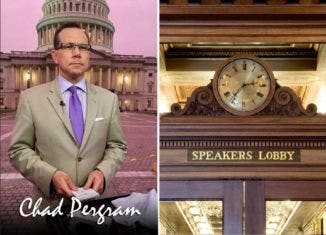Fiscal Vietnam
Congress has entered a fiscal Vietnam.
The Congressional supercommittee designed to find $1.2 trillion in spending cuts finally sputtered this week. The elite panel aimed to find an agreement on what to cut and maybe even hit a target well above $1.2 trillion.
But the supercommittee’s abject failure to forge a pact merely reflects the paralysis which has seized Congress in recent years when it comes to eliminating spending and even passing measures to merely keep the government operating.
Congress is stuck in a quagmire, just like the U.S. was lodged in Vietnam. And it can’t get out.
Like the deep political divisions over the Vietnam war that crippled Congress from taking action for years, battles over cutting spending, running government and increasing the debt ceiling stymie lawmakers now.
In Vietnam, the United States executed a bombing campaign so broad in scope that it was thought it would force Hanoi to negotiate a settlement.
And it failed.
The 12-member supercommittee, comprised of six Democrats and six Republicans, from both the House and Senate, was supposed to be a unique, silver bullet, structured in such a way that it would force Congress to grapple with the spending problem.
But that didn’t work, either.
For decades, Congress has tried measured, tactical warfare to control federal spending. Even big carpet-bombing campaigns like the Gramm-Rudman-Hollings balanced budget act of 1985 (named after former Sens. Phil Gramm, R-TX, Warren Rudman, R-NH, & Fritz Hollings, D-SC), stumbled badly. The government shutdowns of 1995-96, bolstered by a robust economy, helped move the federal government to a surplus and signaled a ceasefire in the conflict for a time. But deficits exploded again a few years later. Baby Boomers began retiring. That enhanced a demand for expensive entitlement programs like Medicare, Medicaid and Social Security, the primary drivers of the federal deficit. September 11th, wars in Iraq & Afghanistan, a bleak economic outlook and expensive legislation, ranging from the financial rescue package of 2008 (known as TARP) to the economic stimulus and health care reform heaped mountains of debt onto the U.S. taxpayer.
And for the better part of this year, Congress has wrestled with ways to curb spending.
In the late 1960s and early 1970s, the Vietnam conflict permeated nearly every debate on Capitol Hill. But the political schisms were so deep that Congress found itself powerless to halt the war.
“This capital is more divided and more pessimistic today than at any time since the beginning of the Vietnam war,” wrote the legendary James Reston in the New York Times on May 17, 1970. “Seldom since the economic depression of the thirties has there been so much gloomy talk here among moderate and thoughtful men.”
In his article, Reston cited faltering economic numbers, mounting causalities overseas, along with a growing social phenomenon.
“The protest movement against the expansion of the fighting into Cambodia is not only closing more and more universities, but increasing the opposition to the military draft, and challenging the President’s authority as Commander in Chief in the Senate,” Reston wrote.
A country split between those who backed the protesters and those who supported “the establishment” hogtied the Senate for years.
And the Vietnam war dragged on.
Today, the country is trifurcated. One third helped elect conservatives win control of the House last fall. Another third is solidly behind President Obama. And the other third is in play. That third voted for Democrats in 2006 & 2008 and sided with Republicans in 2010. Both parties are already into campaign mode for next year trying to secure votes in the middle.
These diverse electoral messages have foiled multiple efforts to make significant inroads into the country’s spending problem. That’s what’s led Congress to careen back and forth between repeated fiscal crises.
In the 2010 midterm elections, voters sent Washington a message. They dispatched a gigantic, conservative class to the House of Representatives. Many of those lawmakers are affiliated with the tea party movement. Once on Capitol Hill, some of them teamed with veteran conservatives who insisted on deep spending cuts. So in February, March and April, Congress fought over significant spending cuts in an episode that brought the government to the brink of a complete shutdown (note that the shutdowns of 1995-96 were only partial). In the end, conservatives were only able to marshal support for a package that cut $61 billion. In fact, many tea party loyalists argued that depending on the accounting mechanism, the savings totaled only tens of millions of dollars.
Then there was the debt limit fight.
Many conservatives pledged they would oppose an increase in the debt ceiling, the total amount of red ink that’s legally permitted to soak the federal government. Republican Congressional leaders argued they’d support a debt ceiling hike, so long as the requisite amount of budget cuts mitigated its effect. For weeks, Vice President Biden huddled with House Majority Leader Eric Cantor (R-VA) and others in an effort to find spending reductions to offset a debt limit increase. Those talks failed, which brought Mr. Obama to the table with House Speaker John Boehner (R-OH). The two men pursued a “grand bargain,” a package of historical spending cuts which would begin to restore the country’s fiscal picture.
But those talks imploded. Congress then hammered out an emergency agreement to increase the debt ceiling and create the supercommittee to find $1.2 trillion in cuts.
This could be the equivalent of then-National Security Advisor Henry Kissinger declaring that “peace is at hand” in 1972.
And the supercommittee effort imploded this week.
In Vietnam, President Lyndon Johnson refused to back down and escalated the war through 1968. The country was split down the middle and that fissure was represented in the Senate.
In today’s quagmire, there is no mining of the Haiphong harbor. There’s no Operation Linebacker II. There’s no Kent State. But the nation is politically torn. These battles over spending and deficits hamstring Congress as it wages a long, bitter campaign to reduce spending. Like Vietnam, the fighting just seems to continue. C-130’s fly home political body bags at the end of every skirmish. Both sides have already defoliated large swaths of the political landscape with white-hot rhetoric on television talk shows.
People often described Vietnam as the “endless war.”
The fiscal war seems endless, too.
That’s what Congress is in the middle of right now. An endless war over federal spending. There will be future battles. Vietnam featured Operation Starlight, Hamburger Hill and the Tet Offensive. The fiscal conflict will feature more fights over keeping the government open, the extension of unemployment benefits and maybe even yet another grand campaign about the debt ceiling.
Each of these fiscal melees sound the alarms and flash lights as the country teeters on the precipice of another disaster. The urgency is reminiscent of the last helicopter out of Saigon.
“This war has already stretched the generation gap so wide that it threatens to pull the country apart,” mused Sen. Frank Church (D-ID) in 1970.
Causalities are mounting in this fiscal Vietnam. And like that war, no one appears to have the political will or ability to stop this conflict either.

